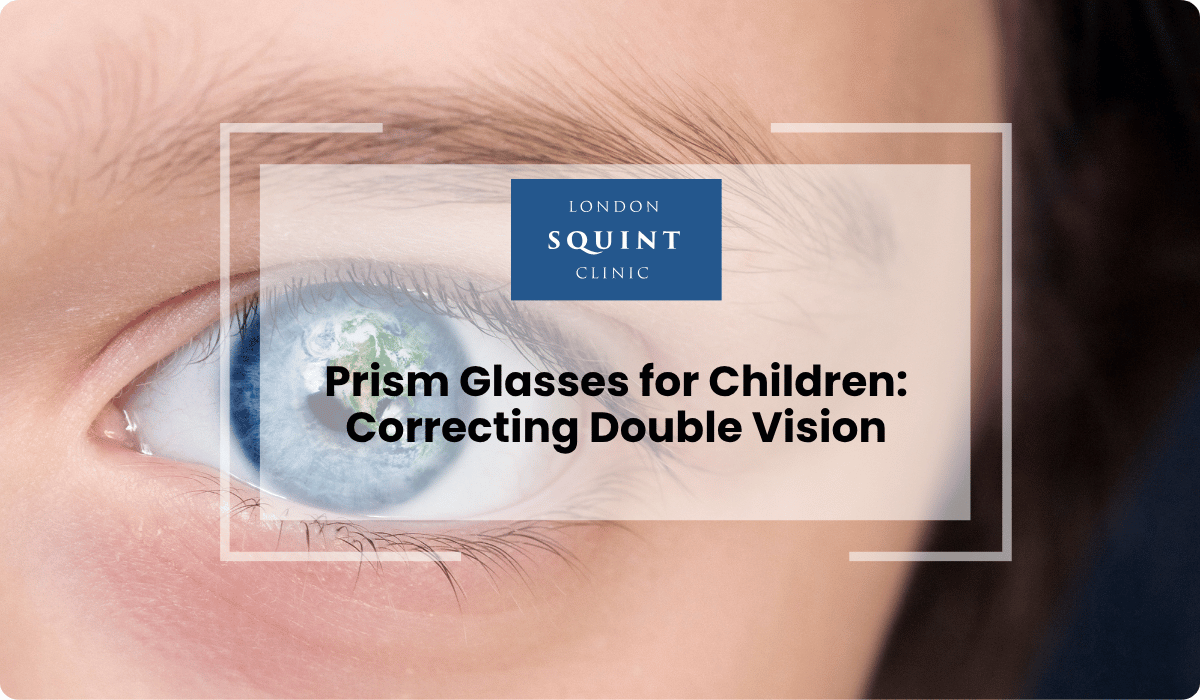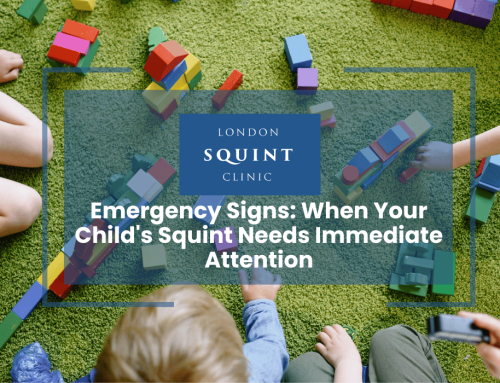Prism Glasses for Children: Correcting Double Vision
Essential Insights: Prism Glasses for Children
- Prism glasses help manage double vision by bending light to compensate for eye misalignment, providing immediate symptomatic relief rather than correcting the underlying condition.
- Common indicators for prism glasses include persistent double vision, decompensating phorias, post-surgical residual misalignment, and certain neurological conditions affecting eye control.
- Options include permanent ground-in prisms for stable conditions and temporary Fresnel prism overlays for changing prescriptions or diagnostic purposes.
- Most children require a 1-2 week adaptation period when starting prism glasses, during which they may experience temporary visual distortions or mild dizziness.
- While prism glasses effectively manage symptoms of childhood squint, they complement rather than replace other treatments like vision therapy or surgery for significant misalignments.
- Regular follow-up appointments are essential to monitor the child’s response and adjust prescriptions as needed during growth and development.
Table of Contents
- Understanding Double Vision in Children: Causes and Signs
- What Are Prism Glasses and How Do They Work?
- When Does a Child Need Prism Correction Lenses?
- Types of Prism Glasses Available for Pediatric Patients
- The Process of Prescribing Prism Lenses for Children
- Living with Prism Glasses: Adaptation and Daily Care
- Do Prism Glasses Help Correct Childhood Squint?
- Long-Term Benefits and Outcomes of Pediatric Prism Therapy
Understanding Double Vision in Children: Causes and Signs
Double vision, or diplopia, occurs when a child sees two images of a single object. This visual disturbance can be particularly distressing for children who may struggle to articulate what they’re experiencing. Childhood diplopia typically stems from eye alignment issues where the eyes aren’t working together properly.
The most common causes of double vision in children include:
- Strabismus (squint) – when one eye turns inward, outward, upward, or downward
- Convergence insufficiency – difficulty maintaining proper eye alignment during close work
- Accommodative esotropia – inward turning of the eyes related to focusing efforts
- Cranial nerve palsies – affecting the nerves that control eye movement
- Post-trauma conditions – following head injuries
Parents should watch for these telltale signs that might indicate double vision:
- Covering or closing one eye when reading or watching television
- Tilting the head to an unusual position
- Complaints of seeing “two” of everything
- Poor depth perception or clumsiness
- Squinting or eye strain
- Headaches, particularly after visual tasks
- Difficulty with reading and schoolwork
Early identification of double vision is crucial for proper intervention, as untreated binocular vision problems can impact a child’s visual development, academic performance, and even social interactions.
What Are Prism Glasses and How Do They Work?
Prism glasses are specialised optical devices that incorporate prisms into the lens design to address double vision and eye alignment issues in children. Unlike standard corrective lenses that primarily focus on improving visual acuity, prism lenses work by bending light before it enters the eye, effectively realigning images to compensate for misaligned eyes.
The science behind prism glasses is based on the optical properties of prisms. When light passes through a prism, it bends toward the base (the thicker part) of the prism. In prism glasses, this principle is utilised to shift the image to a position where both eyes can fuse it into a single, clear picture.
For example, if a child’s eye turns inward (esotropia), a base-out prism might be prescribed. This moves the image outward, allowing the inward-turning eye to see the object in the same position as the properly aligned eye. Conversely, for an outward-turning eye (exotropia), a base-in prism would be used.
Prism correction is measured in prism dioptres (Δ), which indicate the amount of light deviation. The higher the number, the stronger the prismatic effect. For children with mild double vision, a prescription might be as low as 1-2Δ, while more significant alignment issues might require 10Δ or more.
Unlike some vision therapies that aim to strengthen eye muscles, prism glasses don’t directly treat the underlying condition. Rather, they provide immediate symptomatic relief by optically aligning the images seen by each eye, allowing the visual system to process a single, clear image instead of two conflicting ones.
When Does a Child Need Prism Correction Lenses?
Determining when a child requires prism correction involves careful assessment by a paediatric ophthalmologist or optometrist specialising in binocular vision disorders. Several clinical scenarios typically warrant consideration of prism glasses:
Persistent Double Vision: When a child consistently reports seeing two images despite other interventions, prism lenses may be necessary to alleviate symptoms and prevent the development of suppression (where the brain ignores input from one eye).
Decompensating Phorias: Some children have latent eye alignment issues (phorias) that normally remain controlled but become symptomatic during illness, fatigue, or increased visual demands. When these phorias decompensate and cause intermittent double vision, prism correction may help.
Post-Surgical Residual Misalignment: Following strabismus surgery, small residual misalignments that cause double vision might be effectively managed with prism glasses rather than additional surgery.
Neurological Conditions: Children with certain neurological conditions affecting eye muscle control may benefit from prism correction as part of their comprehensive management.
Accommodative Esotropia: When regular glasses alone don’t fully correct an inward eye turn related to focusing efforts, adding prism correction can help achieve single vision.
Bridge to Surgery: In some cases, prism glasses may be prescribed temporarily before planned surgical intervention to assess potential outcomes or provide relief while awaiting surgery.
The decision to prescribe prism lenses is individualised and depends on factors including the child’s age, visual development stage, type and magnitude of eye misalignment, and response to other treatments. Prism correction is typically considered when the benefits of eliminating double vision outweigh adaptation challenges or cosmetic concerns.
Types of Prism Glasses Available for Pediatric Patients
When prescribing prism correction for children, ophthalmologists have several options available, each with distinct advantages for different clinical scenarios and patient needs:
Ground-in Prisms: These are permanent prisms incorporated directly into the lens during manufacturing. Ground-in prisms offer the best optical quality and are typically recommended for long-term use or when the prescription is stable. They’re aesthetically pleasing as the prism is invisible to observers, making them ideal for image-conscious older children and teenagers. However, they can be more expensive and require complete lens replacement if the prescription changes.
Fresnel Prisms: These thin, flexible plastic overlays are applied directly to existing spectacle lenses. Fresnel prisms consist of a series of microscopic prism facets that create the prismatic effect while maintaining a slim profile. They’re particularly valuable in paediatric cases for several reasons:
- They allow for easy adjustment of prism power during the diagnostic phase
- They’re lightweight, adding minimal weight to children’s glasses
- They’re cost-effective when prism requirements are changing
- They can accommodate higher prism powers without making glasses excessively thick or heavy
Split Prisms: For children requiring different prism corrections in different directions (horizontal and vertical components), split prism designs distribute the prismatic effect between lenses. This approach can reduce the thickness of each lens and improve the cosmetic appearance and comfort of the glasses.
Yoked Prisms: These prisms have their bases oriented in the same direction in both lenses. They’re occasionally used for specific neurological visual field defects or certain types of head posturing.
The selection of prism type depends on factors including the stability of the child’s condition, the amount of prism required, cosmetic considerations, and whether the prism is intended as a temporary or permanent solution. For growing children whose prescriptions may change frequently, Fresnel prisms often provide a practical starting point before transitioning to ground-in prisms for long-term management.
The Process of Prescribing Prism Lenses for Children
Prescribing prism lenses for children involves a thorough, methodical approach to ensure optimal correction of double vision while supporting healthy visual development. The process typically follows these essential steps:
Comprehensive Eye Examination: The journey begins with a detailed assessment of the child’s visual system, including visual acuity testing, refraction to determine any need for standard vision correction, and a thorough evaluation of eye health. For younger children, age-appropriate testing methods are employed to gather accurate information even when verbal communication is limited.
Binocular Vision Assessment: Specialised tests evaluate how well the eyes work together, including:
- Cover tests to measure eye alignment at different distances
- Prism bar measurements to quantify the degree of misalignment
- Sensory testing to assess fusion capabilities and depth perception
- Vergence testing to evaluate eye movement coordination
Trial Prism Assessment: Before finalising a prescription, the ophthalmologist will typically perform a trial with temporary prisms. This might involve placing Fresnel prisms on the child’s existing glasses or using a trial frame with prism lenses. The child’s response is carefully monitored to determine if the prism successfully eliminates double vision and improves visual comfort.
Determining Optimal Prism Power: Finding the right amount of prism correction requires balancing several factors:
- The minimum power needed to eliminate double vision
- Avoiding overcorrection that might hinder natural fusion development
- Considering whether to fully or partially correct the measured deviation
Prescription and Dispensing: Once the appropriate prism power is determined, a prescription is written specifying the prism power, direction (base-in, base-out, base-up, or base-down), and whether it should be distributed between both eyes or concentrated in one lens. When choosing the right glasses for your child, the optician will ensure proper fitting and alignment of the prism lenses.
Follow-up and Adjustment: Regular follow-up appointments are essential to monitor the child’s response to prism correction and make adjustments as needed. The prism prescription may need modification as the child grows or as their eye alignment changes.
Living with Prism Glasses: Adaptation and Daily Care
When a child begins wearing prism glasses, there’s typically an adjustment period as their visual system adapts to the new way images are presented to the brain. Understanding this adaptation process and proper care of prism glasses can significantly improve the experience for both children and parents.
Initial Adaptation Period: Most children require 1-2 weeks to fully adapt to prism glasses. During this time, they may experience:
- Temporary visual distortions, particularly at the edges of their vision
- Mild dizziness or spatial disorientation
- Changes in depth perception, especially on stairs or when reaching for objects
- Awareness of the prismatic effect, especially with Fresnel prisms which may cause slight image blurring or halos around lights
Supporting Successful Adaptation: Parents can help their child adjust by:
- Encouraging consistent wear as prescribed by the ophthalmologist
- Starting with shorter wearing periods in familiar environments if adaptation is challenging
- Providing extra supervision during physical activities until adaptation is complete
- Offering positive reinforcement and explaining the benefits in age-appropriate terms
- Communicating with teachers about the child’s new glasses and any temporary adjustments needed
Daily Care for Prism Glasses: Proper maintenance is particularly important for prism lenses:
- Clean lenses daily using appropriate eyeglass cleaner and microfibre cloth
- For Fresnel prisms, use gentle cleaning methods to avoid dislodging the overlay
- Store glasses in a hard case when not in use to prevent warping or damage
- Check regularly for proper alignment, as even slight frame bending can affect prism function
- Schedule regular professional adjustments to maintain optimal fit
Activity Considerations: While prism glasses correct double vision, certain activities may require special attention:
- Sports may require sports-specific eyewear with prism correction
- Swimming and water activities typically require temporary removal of glasses
- Screen time should follow the ophthalmologist’s recommendations, as digital devices can increase visual demands
With proper support and care, most children adapt well to prism glasses and experience significant improvement in visual comfort and function.
Do Prism Glasses Help Correct Childhood Squint?
The relationship between prism glasses and childhood squint (strabismus) is nuanced and depends on the specific type and cause of the squint. Understanding the role of prism correction in squint management requires clarification of what prisms can and cannot achieve.
Symptomatic Relief vs. Structural Correction: Prism glasses primarily provide symptomatic relief from double vision by optically realigning images. They do not physically straighten the eyes or strengthen eye muscles. This distinction is crucial—prisms compensate for misalignment rather than correcting the underlying condition.
Types of Squint That May Benefit from Prisms:
- Accommodative Esotropia: When partially corrected with standard glasses, residual inward turning may be addressed with base-out prism
- Decompensating Phorias: Latent squints that become symptomatic can often be well-managed with prism correction
- Small-Angle Strabismus: Minor misalignments causing double vision may be effectively treated with prisms rather than surgery
- Post-Surgical Residual Squint: Small remaining deviations after strabismus surgery can be addressed with prisms
Limitations of Prism Therapy for Squint:
- Large-angle squints typically require too much prism power to be practical
- Prisms don’t address the underlying neuromuscular issues causing the squint
- They cannot replace surgery for significant
Frequently Asked Questions
How can I tell if my child needs prism glasses?
Signs your child might need prism glasses include covering one eye when reading, tilting their head to an unusual position, complaining about seeing double, poor depth perception, frequent headaches after visual tasks, and difficulty with reading or schoolwork. If you notice these symptoms, consult a pediatric ophthalmologist for a comprehensive eye examination to determine if prism correction is appropriate.
Are prism glasses a permanent solution for childhood double vision?
Prism glasses may be temporary or permanent depending on the underlying cause. For some conditions like accommodative esotropia or decompensating phorias, children may need prism glasses long-term. In other cases, such as post-trauma conditions or as a bridge to surgery, prism correction might be temporary. Regular follow-up appointments are essential to monitor progress and adjust treatment as your child’s visual system develops.
Will my child’s eyes become dependent on prism glasses?
Prism glasses don’t typically create dependency. They provide optical compensation for an existing misalignment rather than weakening eye muscles. In some cases, particularly with younger children, the visual system may actually improve with prism use, potentially allowing for reduction in prism strength over time. Your ophthalmologist will monitor your child’s progress and make adjustments to ensure optimal visual development.
How long does it take for a child to adapt to prism glasses?
Most children adapt to prism glasses within 1-2 weeks. During this period, they may experience temporary visual distortions, mild dizziness, changes in depth perception, or awareness of the prismatic effect. Consistent wear as prescribed is crucial for successful adaptation. Parents can help by starting with shorter wearing periods in familiar environments and providing extra supervision during physical activities until adaptation is complete.
Can prism glasses replace surgery for childhood squint?
Prism glasses can replace surgery in specific cases of small-angle strabismus, decompensating phorias, or when surgery is contraindicated. However, they cannot replace surgical intervention for large-angle squints, as the required prism power would be impractically thick and heavy. Prisms primarily provide symptomatic relief from double vision rather than physically realigning the eyes. Your ophthalmologist will recommend the most appropriate treatment based on your child’s specific condition.
How do I care for my child’s prism glasses?
Clean prism lenses daily using appropriate eyeglass cleaner and a microfiber cloth. For Fresnel prisms, use gentle cleaning methods to avoid dislodging the overlay. Store glasses in a hard case when not in use to prevent warping or damage. Check regularly for proper alignment, as even slight frame bending can affect prism function. Schedule regular professional adjustments to maintain optimal fit, especially as your child grows.
Will my child outgrow the need for prism glasses?
Some children do outgrow the need for prism correction, particularly if the underlying condition improves with age or other treatments. This is more common with certain types of accommodative issues or when prisms are used as part of a comprehensive vision therapy program. However, other conditions may require long-term prism use. Regular follow-up appointments with your child’s eye care specialist will determine if and when prism correction can be reduced or discontinued.
Find out if you are suitable for Double Vision Treatment
Not everyone is eligible for double vision surgery.
Find out if you could benefit from this life-changing surgery by taking the quick self-suitability quiz below:
Our most popular procedures

Hello, I’m Nadeem Ali
I’m one of the few eye surgeons in the world with 100% focus on Squint and Double Vision Surgery.
I have 24 years of eye surgery experience, and worked for 13 years as a Consultant at London’s renowned Moorfields Eye Hospital.
In 2023, I left the NHS to focus fully on treating patients from across the world at the London Squint Clinic. You can read more about me here.
There’s lots of information on the website about: squint surgery, double vision surgery and our pricing.
The most rewarding part of my job is hearing patients tell me how squint or double vision surgery has changed their lives. You can hear these stories here.
Mr Nadeem Ali
MA MB BChir MRCOphth FRCSEd(Ophth)





